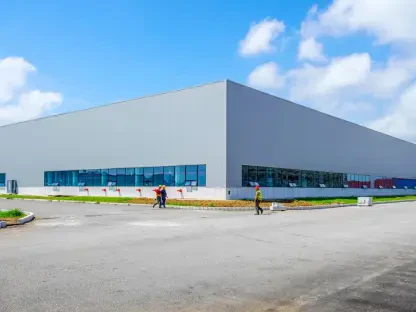In the rapidly advancing realm of warehouse logistics, automated storage systems have emerged as a transformative force. These technologies revolutionize the operations of logistics and warehousing sectors by offering streamlined solutions to long-standing challenges. The integration of robotics and digital management is crucial to transforming storage and retrieval processes into precise, energy-efficient, and scalable operations. One notable example is Shine-Link International Logistics’ recent deployment of an advanced automated storage and retrieval system at its Shanghai facility, serving a global medical device manufacturer. This installation not only meets the storage needs of medical supplies but also showcases the industry’s shift towards embracing technological innovation for efficiency.
An Introduction to Automated Storage Systems
Automated storage systems are a pivotal development in logistics technology, drastically changing how warehouses function. They consist of intricate robotic operations, sophisticated sensors, and management software designed to enhance efficiency and reduce human intervention. Particularly in warehouse environments, these systems enable companies to maximize storage utilization and improve the speed and accuracy of order fulfillment. Emerging from the need to optimize space and labor resources, automated storage systems have become integral to modern supply chains.
The relevance of these systems in today’s technological landscape cannot be understated. As industries strive to meet increasing consumer demands and manage growing inventories, automated solutions provide a competitive edge. They solve complex logistical challenges by leveraging automation, digital tracking, and real-time processing capabilities, making them indispensable across various sectors.
Key Features and Components
Robotic Operations and Mechanisms
Central to these systems is the use of robotics, which facilitates efficient storage and retrieval. In installations such as the one implemented by SLC in Shanghai, robots operate within narrow aisles, navigating both vertically and horizontally with precision. This capability is critical in maximizing warehouse space while minimizing the risk of errors. Robotic systems automate the retrieval and transfer of goods to designated workstations, streamlining order processing and minimizing downtime. The seamless integration of robotics within existing warehouse layouts offers significant operational advantages and promotes infrastructure adaptability.
Energy Efficiency and Sustainability
A notable feature of modern automated storage systems is their energy efficiency, a key consideration given the global emphasis on sustainability. The installations are designed to consume minimal energy; for instance, each robot in SLC’s system consumes approximately 150W per hour. This low energy usage not only reduces operational costs but aligns with broader sustainability goals by minimizing the carbon footprint of warehouse operations. Such efficiencies are achieved through strategic design and advanced technologies that ensure optimal performance without compromising environmental standards.
Latest Developments in Automated Storage Systems
Recent advancements in automated storage systems are paving the way for even greater efficiencies and capabilities. Innovations in design and technology are continually enhancing system performance and adaptability. Industry trends highlight a move towards greater digital connectivity, allowing organizations to benefit from real-time data analytics and improved decision-making processes. This level of integration signifies a shift towards more intelligent warehousing solutions that can predict demand patterns and optimize resource management effectively.
Additionally, consumer and industry behaviors are evolving, demanding more flexible and adaptive storage solutions. These emerging trends influence the trajectory of automated storage systems, prompting advancements that cater to increasingly complex and diverse storage requirements. The continuous development of these technologies promises exciting prospects for the future of logistics management.
Real-World Applications
Automated storage systems are being utilized across a broad spectrum of industries, with notable applications in sectors requiring high precision and efficiency. SLC’s deployment in Shanghai, aimed at fulfilling a global medical device manufacturer’s storage needs, exemplifies how these systems can be customized to accommodate specific industry demands. The integration demonstrates the efficacy of such technology in managing sensitive and high-value inventory, ensuring traceability and availability.
Unique use cases are not limited to the medical industry. SLC’s system, for example, caters to sectors including precision electronics and chemicals, highlighting the versatility and applicability of automated solutions. Such deployments underline a trend towards digitized, traceable logistics, reinforcing the role of automation in contemporary industrial processes.
Challenges and Limitations
Despite their potential, automated storage systems face certain challenges and limitations. Technical hurdles, such as system integration with existing infrastructures, can present initial implementation challenges. Additionally, regulatory issues related to safety and operational compliance can slow down adoption rates in certain regions or industries. Overcoming these obstacles is crucial to ensure the widespread application and success of automated systems.
Efforts are ongoing to address these limitations and promote broader acceptance of the technology. Innovations in design and flexibility, as well as advancements in regulatory frameworks, are paving the way for smoother transitions and greater acceptance across various markets.
Future Outlook
Looking ahead, automated storage systems are poised for significant growth and evolution. Future developments are likely to focus on increasing connectivity, intelligent automation, and further minimizing environmental impact. Potential breakthroughs in artificial intelligence and machine learning could further enhance decision-making capabilities, leading to even more efficient and adaptive systems.
The long-term impact of this technology on the logistics sector and society could be profound, providing businesses with enhanced capabilities to manage inventory and fulfill orders efficiently. As they continue to evolve, automated storage systems will be at the forefront of modern logistics, defining new standards for operational excellence.
Conclusion
In conclusion, automated storage systems represent a critical advancement in logistics technology, offering significant improvements in efficiency, precision, and scalability. From robust robotics to sustainable energy usage, these systems are transforming traditional warehousing practices. While challenges remain, ongoing developments are poised to overcome them, leading to greater adoption and innovation. The future is bright for automated storage systems, with the potential to redefine how industries manage logistics and supply chains globally.









